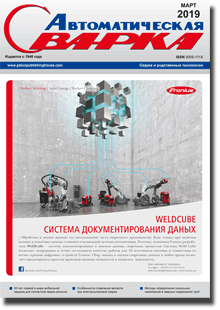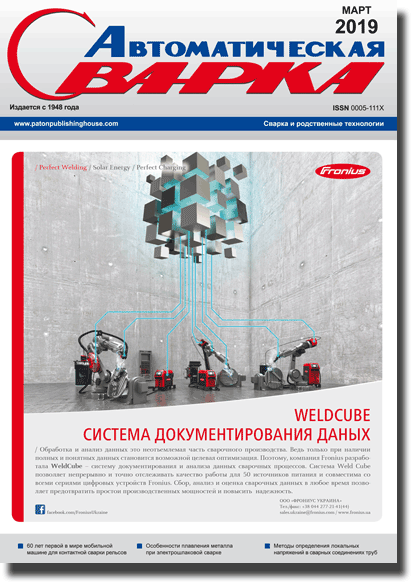| 2019 №03 (02) |
DOI of Article 10.15407/as2019.03.03 |
2019 №03 (04) |

Avtomaticheskaya Svarka (Automatic Welding), #3, 2019, pp. 23-28
Inluence of electrode wire feed rate on base metal penetration in arc surfacing
I.A. Ryabtsev1, A.A. Babinets1, I.P. Lentyugov1, E.V. Turyk2
1E.O. Paton Electric Welding Institute of the NAS of Ukraine. 11 Kazimir Malevich Str., 03150 Kyiv, Ukraine. E-mail: office@paton.kiev.ua
2Institute of Welding, Gliwice, Poland: E-mail: Eugeniusz.Turyk@is.gliwice.pl
Influence of electrode wire feed rate on base metal penetration and geometrical dimensions of deposited beads at submerged-arc surfacing was studied. Four flux-cored wires of 1.2; 1.6; 1.8 and 2.0 mm diameter were used in the experiments. Feed rate regulation was performed in the range from minimum value Vf.min, at which a stable surfacing process can be in place for these conditions, and up to maximum value Vf.max = 450 m/h, which was determined by the characteristics of the used surfacing unit. It is found that at surfacing with high wire feed rates, there exists such an optimum ratio of feed rate and other surfacing parameters for each wire diameter, at which increase of this rate leads to reduction of penetration depth and share of base metal in the deposited metal at rising surfacing current. Results, obtained in this work, were successfully applied at wear-resistant arc surfacing of 3 mm steel sheets, and can also be used in selection of modes of arc surfacing of other parts, which to the greatest extent meet their operating conditions, and requirements to deposited metal and base metal penetration. 10 Ref., 4 Tabl., 5 Fig.
Keywords: arc surfacing, surfacing modes, electrode wire feed rate, base metal penetration, deposited metal formation, flux-cored wire, deposited metal
Received: 28.12.2018
Published: 20.02.2019
References
1. Ryabtsev, I.A., Senchenkov, I.K. (2013) Theory and practice of surfacing works. Kiev, Ekotekhnologiya [in Russian].2. Pokhodnya, I.K., Suptel, A.M., Shlepakov, V.N. (1972) Fluxcored wire welding. Kiev, Naukova Dumka [in Russian].
3. Yuzvenko, Yu.A., Kirilyuk, G.A. (1973) Flux-cored wire surfacing. Moscow, Mashinostroenie [in Russian].
4. Babinets, A.A., Ryabtsev, I.A., Panfilov, A.I. et al. (2016) Influence of methods of arc surfacing with flux-cored wire on penetration of base metal and formation of deposited metal. The Paton Welding J., 11, 17-22. https://doi.org/10.15407/as2016.08.01
5. Frumin, I.I. (1961) Automatic electric arc surfacing. Kharkov, Metallurgizdat [in Russian].
6. Akulov, A.I., Belchuk, G.A., Demyantsevich, V.P. (1977) Technology and equipment of fusion welding. Moscow, Mashinostroenie [in Russian].
7. Panteleenko, F.I., Lyalyakin, V.P., Ivanov, V.P. (2003) Restoration of machine parts: Refer. Book. Ed. by V.P. Ivanov. Moscow, Mashinostroenie [in Russian].
8. Ivanov, V.P., Lavrova, E.V. (2016) Controlling penetration zone formation in arc surfacing. The Paton Welding J., 8, 2-6. https://doi.org/10.15407/as2016.11.04
9. Ryabtsev, I.O., Babinets, A.A., Lentyugov, I.P. (2018) Method of submerged-arc surfacing with flux-cored wire. Pat. 127598, Ukraine [in Ukrainian].
10. Babinets, A.A., Ryabtsev, I.A. (2017) Flux-cored wire for wear-resistant surfacing of thin-sheet structures. The Paton Welding J., 1, 54-57. https://doi.org/10.15407/as2017.01.10
The cost of subscription/purchase order journals or individual articles
| Journal/Currency | Annual Set | 1 issue printed |
1 issue |
one article |
| TPWJ/USD | 384 $ | 32 $ | 26 $ | 13 $ |
| TPWJ/EUR | 348 € | 29 € | 24 € | 12 € |
| TPWJ/UAH | 7200 UAH | 600 UAH | 600 UAH | 280 UAH |
| AS/UAH | 1800 UAH | 300 UAH | 300 UAH | 150 UAH |
| AS/USD | 192 $ | 32 $ | 26 $ | 13 $ |
| AS/EUR | 180 € | 30 € | 25 € | 12 € |
| SEM/UAH | 1200 UAH | 300 UAH | 300 UAH | 150 UAH |
| SEM/USD | 128 $ | 32 $ | 26 $ | 13 $ |
| SEM/EUR | 120 € | 30 € | 25 € | 12 € |
| TDNK/UAH | 1200 UAH | 300 UAH | 300 UAH | 150 UAH |
| TDNK/USD | 128 $ | 32 $ | 26 $ | 13 $ |
| TDNK/EUR | 120 € | 30 € | 25 € | 15 € |
AS = «Automatic Welding» - 6 issues per year;
TPWJ = «PATON WELDING JOURNAL» - 12 issues per year;
SEM = «Electrometallurgy Today» - 4 issues per year;
TDNK = «Technical Diagnostics and Non-Destructive Testing» - 4 issues per year.





